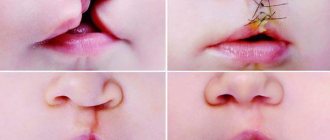““In one of the issues of the magazine “Faces” (currently the magazine, which was part of the “Top Secret” media holding, is closed - author’s note)
An interview was published with a fashionable plastic surgeon from the Moscow Institute of Beauty, Evgeny Lipkin. In particular, Lipkin spoke about one immutable rule of his profession - never, for any money, do secret plastic surgery. The price of such an operation may be the doctor’s life. After all, the surgeon is in any case the last in the chain of those who will know the new face of the person who wished to hide.
Six years ago, in 1991, we began investigating two covert operations - one surgical and one international KGB special operation. Both operations were closely related and were successful. True, then the surgeon died under strange circumstances...
Secret mines of the “party gold”
The autumn of 1991 was, as you remember, stormy and politically promising. It was a time of mysterious suicides, inexplicable appointments and rapid resignations. Under the flags of hungry and evil democracy, the clan of “always second” was pushing its way to power. Young people are cherished everywhere, but old people were not given any respect in this mess of ambitions. It was timelessness. How else can we explain the fact that one of us managed in those September days to quite calmly negotiate with one of the employees of the International Department of the CPSU Central Committee and enter the sacred Old Square - the 3rd entrance of the building of the Central Committee of the Party.
“Of course, I won’t let you into my department, but go ahead to the next one,” said the party diplomat and led him into the office of the Portuguese department of the CPSU Central Committee. Half a day for journalistic plunder. Whole deposits of secret documents were kept there, revealing the mechanisms of our financial support for the Communist Parties of Portugal and Spain.
Now, six years later (this text was written in 1998 - author's note)
When the accusatory pathos subsided, it must be admitted that they knew how to work professionally in the international department of the Central Committee. The schemes for financial support of “friends of the party” were cunning and original. And if earlier these financial mechanisms were used “to strengthen the international influence of the USSR,” now, probably, the same professionals use them “for personal purposes” to pump domestic capital abroad. This, in fact, was the main secret of the “gold of the party,” the mysteries of which were discussed so much in 1991.
So, after a detailed and sensational for its time publication in Komsomolskaya Pravda about the “Portuguese gold of the party,” we began an affair with the investigative team of the General Prosecutor’s Office of Sergei Aristov, which was conducting a criminal case about financial abuses of the Old Square, recall journalists Sergei Sokolov and Sergei Pluzhnikov. (Sergey Alekseevich Aristov in 2002 became the head of the Main Investigation Department of the General Prosecutor's Office of the Russian Federation, then moved to the Ministry of Railways, and since 2005 he has been working as Deputy Minister of Transport of Russia - author's note)
Now everyone is accusing investigators of malicious “information leaks”, and journalists of selling commissioned articles. And for some reason, the fact that everyone is simply doing their job for mutual benefit is completely excluded from view. For more than a year, while the investigation was ongoing, we told Komsomolskaya Pravda readers about the shadow sides of the life of our state. And from time to time, our publications helped the investigation in moments of crisis, since it affected the financial interests of too high-ranking persons. In addition, from time to time investigators in their excavations came across stories that had nothing to do with the financial transactions of the CPSU. This is how we learned about the brilliant action of illegally transporting the Secretary General of the Communist Party of Human Rights, Luis Corvalan, from the USSR to Chile. But neither we nor the investigators in the case of the “gold of the party” suspected then that behind the unique special operation of the international department of the CPSU Central Committee and the KGB lay the mysterious death of the Moscow plastic surgeon Alexander Sergeevich Shmelev. But let's not get ahead of ourselves. In the beginning there was a secret special operation by our intelligence and the CPSU Central Committee.
Mystery of room No. 516
On October 20, 1991, the operational-investigative team of the Russian Prosecutor General's Office began inspecting room No. 516 in the main building of the CPSU Central Committee building complex on Old Square. Everything here testified to the hasty covering up of traces of top-secret activity: the machines for destroying documents were overflowing with paper shavings, whole armfuls of them were lying on the floor, many folders of archival files turned out to be empty or destroyed... When examining a strange room (with a total area of more than 200 sq. m.), investigators discovered presses for embossing stamps on passports, complex computerized photographic equipment, a huge collection of ink, ink, stamp mastic, samples of forms of various foreign official documents, a large card index consisting of photographs of people of all nationalities and skin colors, as well as rubber matrices of fingerprints, wigs, fake mustaches and beards, contact lenses to change eye color and much more.
Upon further investigation, it was established that before the August events, room No. 516 was occupied by the so-called Party Equipment Group under the international department of the CPSU Central Committee. Officially, employees of this group were involved in processing documents for foreign citizens arriving in the USSR at the invitation of the Politburo. And unofficially, the group, in cooperation with the KGB, ensured the livelihoods of the leaders of fraternal parties and communist movements who were illegal in their countries - in Turkey, El Salvador, South Africa, Chile...
The beginning of the activities of the Party Technology Group, or “sector A,” dates back to the times of the Comintern. Its permanent leader since 1937 was Ivan Kolyuka (died more than ten years ago). Over the years, the group changed its size. Until 1985, it employed 12 specialists, then until 1989 - 9, and in the last years before the death of the CPSU - only 3 people. The history of the group is still shrouded in state secrets. But some details that we were able to find out indicate that her activities were far from ordinary.
After the war, the gold attributes of the uniforms of senior Wehrmacht officers were kept in the archives of the group for a long time, but among the employees there was a thief who began to slowly sell fascist gold to the left. The swindler was quickly identified and punished.
Before one of the congresses of the CPSU, the question of disbanding “sector A” arose, but all the general secretaries of all the communist parties in the world wrote a collective letter in defense of Ivan Kolyuka and his charges! And the group survived.
In 1990, in “sector A” an American intelligence agent was exposed. Through what channels the KGB found out that former GRU officer and photographer of the group Nikolai Chernov, during a trip to the United States in 1972, handed over some photographic materials to the CIA is unknown. Chernov was imprisoned for 15 years and released under an amnesty after the August putsch.
Among the pile of top-secret documentation in room No. 516, investigators found four plump folders with the inscription “Operational file “Jorge” No. 5613 dated March 15, 1983.” Now we can already tell you that we also held this case in our hands, leafed through the yellowed pages of its three volumes, very much regretting that we did not take the Minox microphoto camera with us. (Yes, Komsomolskaya Pravda journalists already had such a “spy” camera at that time - author’s note)
We were not even allowed to look at the fourth volume, which contained confidential information about numerous KGB illegals who participated in the development of Operation Domingo.
Operation Domingo
On January 27, 1983, decision P-95/65 of the Politburo of the CPSU Central Committee marked the beginning of a top-secret operation codenamed “Domingo”. Its meaning boiled down to changing the appearance of the legendary Luis Corvalan and the illegal transfer of Brezhnev’s favorite to Chile for the underground fight against the Pinochet junta.
It was officially believed that since 1977, when Corvalan was exchanged in Switzerland for the dissident “hooligan” Bukovsky, the leader of the Communist Party of Czechoslovakia with his wife and daughters lived in Moscow. In fact, he spent from 1983 to 1989 in the Chilean underground. Most likely, the end result of Operation Domingo was to be a new coup in Santiago and the communists coming to power.
Hundreds of people worked on the development and implementation of Operation Domingo, and it can rightfully serve as an example of conspiracy. Illegal immigrants and KGB residents, Chilean friends and employees of the Party Equipment Group of the Politburo of the CPSU Central Committee did a huge, painstaking job of compiling a “legend” for Corvalan (code name “Jorge”)
. However, Corvalan himself also took an active part in the creation of his new biography - he came up with the names of his deceased parents, and suggested details of Chilean life.
Luis Arturo Perez was born
- born on August 2, 1921 in Bogota (Colombia), married, higher education, psychologist, place of work - diplomatic department of the university, height 1.60 m, straight nose, dark brown hair...
Everything in this operation was thought out to the smallest detail and to the minute: from the color of the shirt and the style of the suit (the clothes were specially delivered from Colombia) to the names of the hotels in which Corvalan was recommended to stay.
Directly to the delivery of Corvalan to Chile through Argentina, specialists from the Red Banner Institute named after. Andropov was not prepared for long, but thoroughly. He had to go through an entire spy course in a matter of weeks. Lectures on the brutal nature of US imperialism were interspersed with practical classes on topics: avoiding surveillance, the basics of psychological preparation for the conditions of secret activity, etc.
It was during this period that the surgeon Alexander Shmelev performed a series of plastic surgeries on the Secretary General of the Communist Party of Human Rights. Moreover, the operations took place not in the clinic of the 4th Main Directorate, but somewhere in closed special dachas near Moscow, where the surgeon was sometimes taken for a day or two. Returning one night from such a trip, he told his wife: “I changed Corvalan so that now his own mother will not recognize him.”
Judging by the materials of the operational case, comrade Jorge underwent plastic surgery on his nose, his hair color and hairstyle were changed, glasses and contact lenses were selected for constant wear, work was done on his teeth, and he was given special belts to reduce his overall weight and some changes in his figure and gait. Among other things, the secret relocation of the leader of the Chilean communists was supposed to be ensured by two doubles, who, apparently, also underwent plastic surgery under Jorge. One of the doubles was called upon to check Jorge's delivery route. He reached Chile without any problems. And after him, two weeks later, on Aeroflot flight No. 351, Luis Arturo Perez took off along the beaten path to Buenos Aires with $600 in his pocket. On August 23, 1983, he arrived in Santiago without any problems. And at this time, Corvalan performed “live” on Soviet television in Moscow - these speeches were prepared ahead of time, back in May. Unfortunately, his operational file does not contain information about Jorge’s illegal life in subsequent years in Chile.
The secret of Lyubov Orlova's second youth
One of the last film works of the famous Soviet director Alexandrov was the film “The Starling and the Lyre” with Lyubov Orlova in the title role. The audience, who knew full well that their favorite actress was somewhere around seventy, was literally stunned to see in the film a woman who could equally have been fifty or forty years old.
Of course, Orlova was an amazingly resilient person, but at the same time there was a secret to her youth, which she, like any woman, was not going to advertise. The mechanic of the popular actress’s “time machine” was a plastic surgeon from the Moscow Institute of Beauty, Alexander Sergeevich Shmelev. Shmelev made people younger and more beautiful - that was his profession. In addition to Orlova, he operated on actresses Maksakova and Tarasova. The beautiful half of the entire Moscow party-nomenklatura elite made an appointment with him. And it was thanks to Shmelev that the noses of the wives and daughters of many Politburo members acquired classic shapes. There were no more than a dozen specialists of this class in the world.
His death was strange and painful. On Friday evening, February 3, 1986, Alexander Sergeevich, without warning anyone, unexpectedly left for his dacha in Tomilino. He left as if someone had arranged a very important meeting for him. And only on Sunday, alarmed, my cousin rushed there. Having broken open the door that was closed from the inside, he found the surgeon lying on the floor, still alive. Shmelev died for more than a day. But he was never able to utter the last, apparently very important words.
Shmelev’s death certificate states: “Impaired cerebral circulation, cerebral edema, resulting from a blow to the cervical vertebrae on the corner of a wooden table.” This official version did not confuse anyone then. For the last year, the surgeon had been drinking a lot and, as a man who had lost a leg during the war, he, in the opinion of those around him, could well have fallen so unnaturally (collapsed with his back on the corner of the table).
But today, years later, some facts have become known about which Shmelev was ordered to remain silent. It is possible that his tragic death was precisely due to the fact that he could inadvertently break his vow of silence. By the way, shortly before Shmelev’s death, his colleague from the capital’s Institute of Beauty, also a plastic surgeon, died of a heart attack. He painted the baseboards with some strange paint and died overnight.
Shmelev was not only a “ladies man,” but also the only plastic surgeon consultant to the foreign department of the 4th Main Directorate of the Ministry of Health. There is no doubt that he also worked for the KGB. Not a single intelligence service in the world has yet managed to do without changing the appearance of its illegal immigrants. But what Shmelev had to do in 1982-1983 goes beyond the scope of ordinary intelligence activities. The mysterious details of the biography of Alexander Sergeevich were revealed almost by accident and unexpectedly after the August putsch.
Owner of room No. 516
The employees of the Party Equipment Group of the CPSU Central Committee did not tell the investigators of the Prosecutor General's Office anything about their secret activities, citing a subscription to non-disclosure of Soviet state secrets. And we are still at a loss as to why the last head of “sector A”, Vladimir Osintsev, agreed to meet with us in an empty room at the Oktyabrskaya Hotel. He was talkative, but hardly entirely frank.
— One of the common reproaches against the special group: the CPSU Central Committee, not even trusting the KGB, created its own special service, internal “party intelligence”...
- That's not entirely true. We only fundamentally protected our charges from direct contacts with the KGB. After all, such connections would automatically expose them to charges of espionage. In recent years, we have been almost inactive; the time of multi-step operations has passed along with the attractiveness of the ideas of the world trade movement.
- We learned about one such operation - “Domingo” - by chance at the Prosecutor General’s Office...
— This operation, so you know, was preceded by a powerful failure. On August 27, 1980, Paraguayan communist leader Antonio Maidana disappeared without a trace in Buenos Aires. The press then assumed that professionals from Stroessner’s intelligence services could have tracked him down and killed him. To all inquiries, the Argentine federal police responded: “A person with that name has not crossed the borders of Argentina.” And this was indeed the case. Maidana underwent special training with us and came to Buenos Aires under a different name. There were no mistakes on our part. Maidana simply did not want to study. Well, you can’t force the Secretary General to practice avoiding outdoor surveillance. He entered Argentina without any problems. But he was not a professional illegal immigrant, but simply a brave man. As we later found out, Maidana had recently made appointments with his contacts in the same place. It was this miscalculation that led to the tragic outcome.
— So, out of caution, you decided to send Corvalan to Chile with a changed appearance?
“It was a successful transformation, but without a change in appearance. It would be nice if the secretary general was changed beyond recognition by a doctor. Corvalan had the gift of an actor. On one of his visits to the USSR for treatment, he told me that at an underground meeting of the Political Council, even his secretary, who had worked with him for many years, did not recognize him. Or rather, she was able to recognize Jorge only during the break, by his gait, which the Secretary General was unable to change - age. ...I’ll be honest, my soul doesn’t hurt for everything I’ve done. We helped people survive who were in real danger of physical destruction. We almost always succeeded. And at least one life saved justifies our work.
— The romance of the revolutionary struggle is, of course, exciting. But what about supporting terrorist organizations?
“We taught people to defend themselves, not to attack, we taught them to defuse explosives and listening devices, and to ensure the safety of their leaders. What was this for? Suffice it to recall the powerful explosion that destroyed the premises where the Argentine Communist Party activists held meetings, immediately after its legalization. Or this fact: the CIA, shortly before the coup in Uruguay, in the building of the Communist Party, replaced all the lighting equipment - with an identical one, but with listening devices... Of course, we could not keep track of the fate of each of our graduates.
Their destinies could have turned out differently. And in this regard, we should not forget that the United States invested $150 billion in the bloody dictatorial regimes of Latin America. In short, we simply tried to maintain parity. (Vladimir Osintsev is no longer alive. In recent years, Osintsev worked in the office of the Speaker of the State Duma of the Russian Federation Gennady Seleznev. We once met him by chance in the corridor of parliament - author's note)
The mystery of the death of surgeon Shmelev
The whole absurdity of the situation in this story with Operation Domingo lies in the fact that we, already absolutely knowing about the “general” change in Corvalan’s appearance in 1983, heard the testimony of two Moscow Chileans that now their Lucho, living in a villa near Santiago , looks exactly the same as before in his portraits. Only, of course, he got older.
To finally solve this problem, we got through to Luis Corvalan in Chile, journalists Sergei Sokolov and Sergei Pluzhnikov write:
“In 1983, I actually returned to Chile illegally, but I didn’t have any plastic surgery,” Luis Corvalan told Sergei Sokolov in a telephone conversation. — Did you have doubles? - No, it's just a legend. — What can you tell us about Operation Domingo? “I don’t know anything about this,” this is how the old conspirator ended his short conversation with us.
However, we have solved this riddle. In the archives of the Central Committee we found an interesting document signed by the deputy head of the international department of the CPSU Central Committee, K. Brutents, dated July 17, 1989: “... to provide assistance in traveling from the USSR to one of the countries of Western Europe to obtain a Chilean passport for the purpose of subsequent legal return to their homeland to the former Secretary General of the Communist Party of Czechoslovakia, Comrade Luis Corvalan. Comrade L. Corvalan will arrive in Moscow at the end of July 1989 for rest and treatment... He will leave Chile illegally, with a changed appearance...".
And the former director of the Moscow Institute of Beauty, Inna Kolgunenko, in a conversation with us, made her conclusion: “although a complete restoration of the previous appearance is impossible, surgery allows for partial “reverse” surgery (restoration of the shape of the nose and chin).”
But the death of surgeon Alexander Shmelev remained a mystery, which, in essence, forced us to take up this investigation. Perhaps, not wanting to help us in solving it, with one voice both Vladimir Osintsev and Comrade Jorge now completely denied (in 1992) the very fact of carrying out plastic surgeries, which were provided for in the plan for Operation Domingo.
PS We are publishing a list of medical personnel who took part in operations to change the appearance of the Secretary General of the Communist Party of Human Rights in the hope that these people, if they are, of course, still alive, will help us bring the journalistic investigation to the end:
Vostrikova Eleonora Petrovna - head. department Shankina Tamara Nikolaevna - sister-hostess Rubashkina Irina Viktorovna - head. Operations block Nina Petrovna Baklanova - head. 2nd therapy of the foreign department Ivanov Boris Nikolaevich - dentist-prosthetist Tatyana Kuzminichna Starodubtseva - nurse Nina Lvovna Penzina - nurse Elena Aleksandrovna Kamenshchikova - nurse Maria Mikhailovna Mozhaeva - nurse Nina Ivanovna Fomicheva - nurse
(We took this list from the Domingo operational case)
Many years later
Luis Corvalan, who flatly denied everything in 1992, confirmed his participation in Operation Domingo only in 2005 in an interview with KP journalist Oleg Yasinsky: “The details of my return to Chile were published by the Komsomolskaya Pravda newspaper in the issue dated March 17, 1992 of the year". Thus, this fact has already completely gone down in history.
In the history of the world communist movement. Thus, all our research, which we carried out at our own peril and risk in the turbulent post-perestroika times, was successfully confirmed,” recall journalists Sergei Sokolov and Sergei Pluzhnikov.
It was a golden time - the early 90s. In one year, we managed to obtain as many documents with the highest secrecy classification “Special Folder” as we later did not dig up during the nine years of the Yeltsin era. Who knew then whether it was dangerous or not? Until 1996, it was not clear whether the communists would return to power in Russia or would forever become part of history. And if they return, what will they do with the whistleblowers? But we didn’t even think about it, since we began our journalistic careers at the end of perestroika and glasnost, when it was already possible to write not only about the Stalinist regime, but about the more recent secrets of the dictatorship of the party apparatus: about the party’s gold, about the illegal financing of foreign Communist parties, about the multimillion-dollar fraud of “friends’ companies” with oil, about the supply of weapons by the KGB to Lebanese terrorists... Glavlit and UG already existed for us purely nominally. And we will never forget this euphoria of journalistic permissiveness, when the Komsomol Central Committee was already in its death throes, and the future oligarchic owners were still selling jeans and porn in the underground passage on Tverskaya, the buzz from the multimillion-dollar circulation of Komsomolskaya Pravda.
Now, it seems to us, the time has come for historians or screenwriters. The extraordinary adventures of Luis Corvalan could fill an entire Hollywood blockbuster or an adventure novel. (Luis Corvalan died at the age of 94 in Santiago - July 21, 2010 - author's note)
Moreover, a large number of detective details remained outside the scope of our newspaper narrative. For example, we did not say anything about the fact that when Comrade Lucio was in prison located on a Chilean island, the Politburo of the CPSU Central Committee was seriously planning an operation to free him with the help of several nuclear submarines
. And much more. It’s even a pity that such material is still collecting dust in the archives.
In general, we are quite skeptical about the phrase “investigative journalism.” It undeservedly replaced a more capacious and shorter definition - “reporter”. It’s just that there are guys who limit themselves to daily statements of facts - “in the room” (written and forgotten), and there are investigative reporters who spend weeks or even years trying to figure out what actually stands behind this fact and what really happened in fact. And for this you do not need to have any special super qualities: only patience, perseverance and caring attitude towards people (witnesses and participants in events).
Investigators of the Prosecutor General's Office of the Russian Federation, who, after much hesitation, finally showed us that very cherished “Jorge Case,” asked us to forget about Corvalan’s reincarnation for about a year. And we forgot. What is a newspaper sensation if as a result both the careers of the investigators themselves and the heroes of the special operation “Domingo”: Corvalan’s comrades, our illegal intelligence officers, could suffer? But during this year of forced silence, we slowly searched for and found participants and witnesses. This was not easy, given that on the unbridled wave of the victory of democracy, any mention of the abbreviation CPSU looked like a shameful stigma. We managed to convince our interlocutors of our sincerity. And first of all, we are reporters and do not engage in politics. Before us was an amazing detective story, the ends of which needed to be unraveled. We were really able to appreciate the professional work of the guys from the PGU of the KGB of the USSR, who managed to pull off a very complex operation, and as a result, another classification of secrecy was removed. Although to this day the former chief of Soviet intelligence Leonid Shebarshin grumbles at meetings: secret documents are not intended for publication. (Leonid Vladimirovich Shebarshin - former head of foreign intelligence, head of the PGU KGB of the USSR - died on March 30, 2012 - author's note)
We were unable to answer only one question: how did surgeon Alexander Shmelev die? Was it really an accident? Journalists will not answer this question. We still hope that if the death of a talented doctor was not accidental, then someday a telephone call will ring in our editorial office and a person will show up who will tell how everything really happened. So even after so many years, our investigation continues, despite the fact that we now work not at Komsomolskaya Pravda, but at the FreeLance Bureau Federal Investigation Agency (www. flb.ru), despite the fact that, it would seem, Against the backdrop of current events, no one is interested in this anymore.
In principle, thanks to the painstaking work on unraveling the “Jorge Case” and other similar stories in Komsomolskaya Pravda, we became professionals. And at that time they didn’t even think about how much such Sisyphean labor could cost. For us, it was just a good school, which we wish everyone who seriously intends to engage in investigative journalism to go through.”
Sergei Sokolov, Sergei Pluzhnikov, 1998.
In the photo: Lyubov Orlova, Grigory Alexandrov, surgeon Alexander Shmelev. 1973, on the set of the film “Starling and Lyra”
From the editors of FLB:
By the way, this work of reporters S. Sokolov and S. Pluzhnikov became a classic example of investigative journalism and was included in journalism textbooks. (For example, see Yu.A. Shum, “Journalistic investigation: from theory to practice” - M.: “Galeria”, 2002.)
Vesti program, 09.14.2006
“The secretary with whom he worked for a long time, on the first day, when Corvalan gathered everyone at the safe house, did not even recognize him,” says Sergei Sokolov, editor-in-chief of the magazine “Country and Power”, author of a study on the life of Luis Corvalan.”
“Channel One”, 09.14.2006
“And in 1983 it was decided to illegally transport him to Chile. He had plastic surgery. They changed the shape of his eyes and removed the famous hump on his nose, for which the party called him Condorito - Eaglet. The secret transfer almost fell through."
“Komsomolskaya Pravda”, 09/17/2013. Alexey Bogomolov
“On September 14, on Corvalan’s birthday, a presentation of the book by Sergei Golosov, a veteran of the 9th Directorate of the KGB of the USSR, “Memories of the Leaders of the Red Movement, or the Book of Those Who Ruled the Country and Served It,” took place. It contains the memories of many state security employees, including Sergei Yakovlevich himself, who guarded Luis Corvalan from the moment of his arrival in the capital of the USSR.” »
Who works in the institution
Below is a list of specialists who work at Plastic surgeon Shmelev I. S.:
To add specialists, fill out the form below:
Add Add... By submitting the form data, you automatically agree to the site's privacy policy.
How do you register at the hospital? (Number of votes: 41335)
Through the Internet
By phone
I visit the registry in person
I can't sign up
To vote, click on the desired answer. results
Plastic surgeon Shmelev I. S.
Rating: 4 4 ratings
Making an appointment with a doctor for plastic surgery “Plastic surgeon Shmelev I. S.” pay attention to the features:
payment by cardYes
Working hours during which you can make an appointment with a doctor are Mon-Fri 9:00–20:00
Plastic surgeon Shmelev I.S. is located at: 2nd Sadovaya st., 72, Saratov
Appointment card
Interesting: How to make an appointment with a doctor through the Gosuslugi portal









